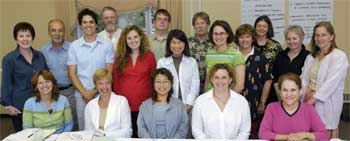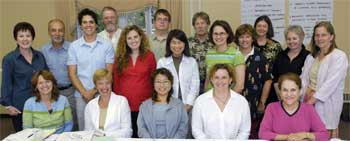 18 faculty members go back to school
18 faculty members go back to school
KINGSTON, R.I. — September 7, 2006 — Walking to the head of the class and pulling out aged, yellow-lined paper filled with notes and reading them to students isn’t Roger LeBrun’s idea of teaching.
The entomologist earned advanced degrees and had extra training in his specialty—but like most college professors–had no formal training in teaching. When he came to the University of Rhode Island in 1977, he was selected as one of 12 faculty members selected for the Lilly Postdoctoral Teaching Fellowship Program, funded by the Eli Lilly Endowment. The group traveled the country, developing teaching techniques and discussing philosophies. “It wasn’t about ‘just teaching’ it was about teaching quality,” he said.
URI’s Teaching Fellows Program was institutionalized the following year and has been offered annually ever since. This academic year, 18 faculty members meet regularly to exchange ideas about university teaching and learning. The program provides the faculty members an opportunity to read and reflect on teaching, discuss teaching methods and course planning, try different techniques in their classrooms, and get to know colleagues from a variety of disciplines. The Fellows met twice in August and will meet twice a month throughout the 2006-2007 academic year.
Faculty are not compensated for their time. “They come because they truly care about teaching,” says Bette Erickson, director of URI’s Instructional Development Program, who coordinates the Teaching Fellows. This year, Breck Peters, sociology, and Nedra Reynolds, college writing program, will help coordinate the program. Both are alums of the program.
New and veteran faculty members become Fellows.
Barbara Meagher joined the URI Journalism Department in 2003. “I jumped at the chance to have regular discussions with Bette (Erickson) and other professors who want to improve their skills. My sense is that the program will be packed full of information,” she says after her second session. “Part of the time, we turn to the people sitting near us and talk about a teaching style that worked for us. It all leads us to think about the variety of learning styles our students have and what approaches we might develop to help them.
“Teaching is like jazz, there are always variations on the theme,” says LeBrun who each year works with new faculty in the instructional development program’s workshops. “My classes vary every time, depending on the audience,” he says, noting that he uses a number of teaching techniques to keep his students engaged. “I try to pull examples from modern culture. For example, bugs use songs, a rhythm, to communicate and court each other,” the entomologist says. “Someone studied the rhythm of grasshoppers and discovered the patterns of sound are very similar to hip hop music. So I tell my students hip hop isn’t so new, it dates back at least to 400 million years.”
LeBrun recently spoke with a former student from the ‘70s. “She remembered that I told her that termites taste like pineapple,” he laughs. “But that’s what teaching is all about, making things unforgettable.”
Pictured above
Class of 2006
URI Faculty Fellows return to class
URI’s 2006 Faculty Fellows (seated l-r) Kathleen Gorman, Feinstein Center for a Hunger Free America; Alison Homan, Counseling Center; Sookhyun Kim and Susan Hannel, textiles, merchandising and design; Carolyn Livingstone, music; (standing 1-r) Barbara Meagher and John Pantalone, journalism; Mike Pennell, college writing; Daniel Carpenter, languages; Kelly Orr, pharmacy practice; Peter Larsen, Library; Su Wu, business administration; Breck Peters, sociology; Kristina Ward and Celia MacDonnell, pharmacy; Bette Erickson, director of Instructional Development Program; Lynne Derbyshire, communications studies; and Pamela Rohland, disability services for students. Missing from the photo are: Kyle Kusz, kinesiology; and Tracey Townsend, Counseling Center. URI News Bureau Photo by Michael Salerno Photography.

